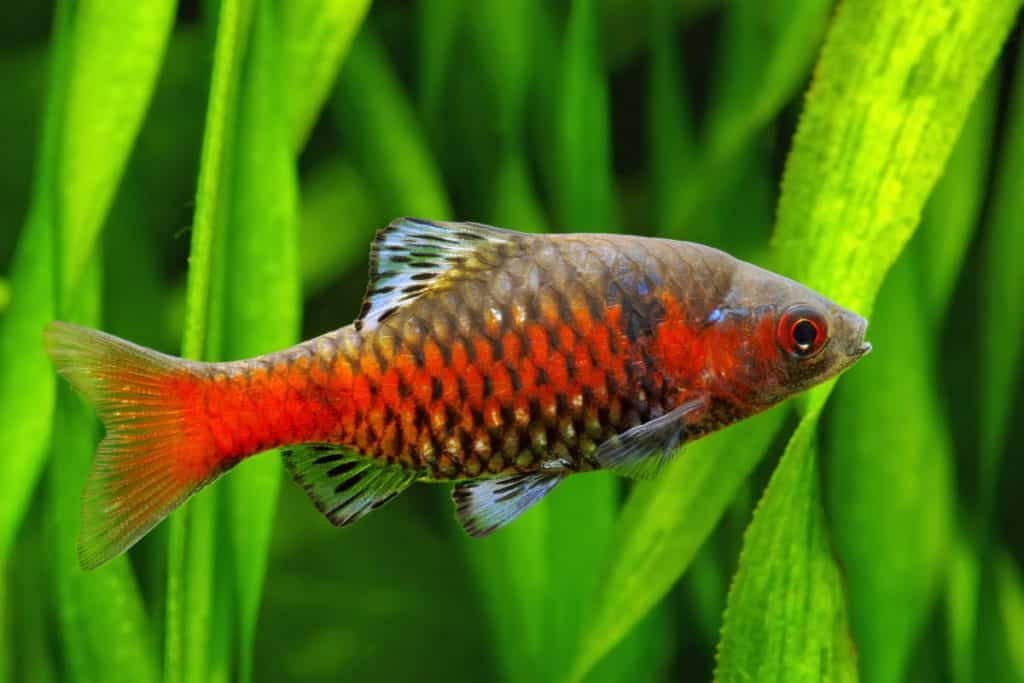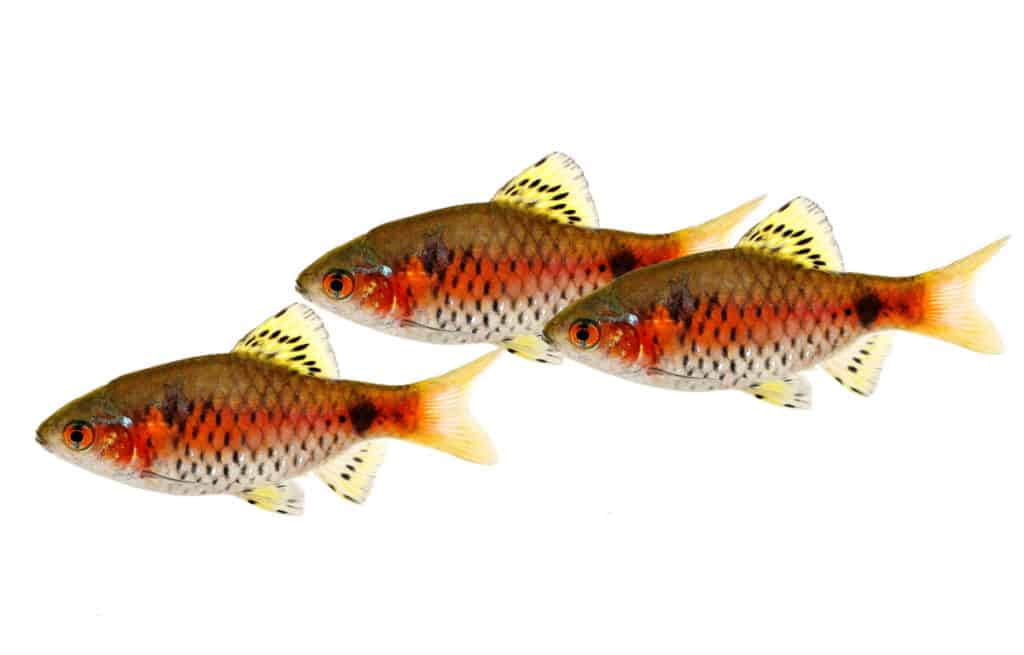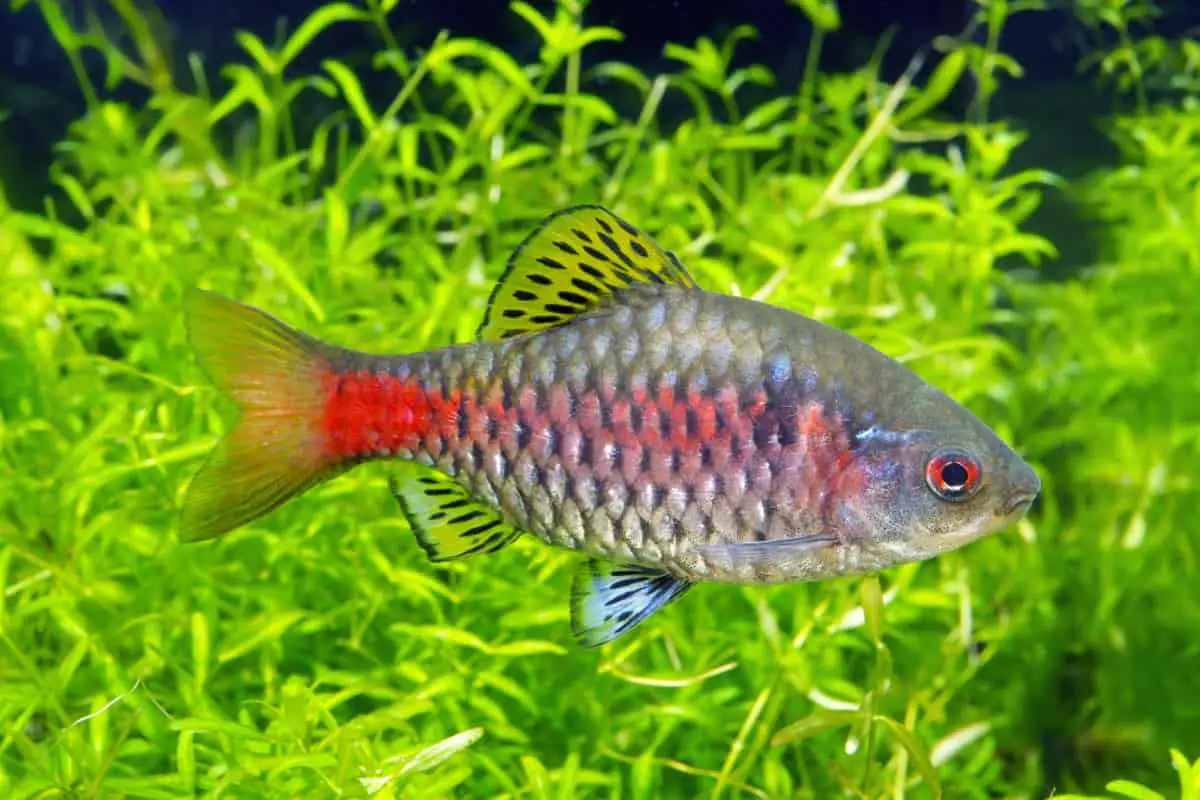The Odessa Barb is a small, bright, and active aquarium favorite that is ideal for the beginner aquarist. Here is our Odessa Barb Care Guide.
They are thought to have appeared in the pet trade in Odessa, Ukraine in the 1970s, hence the name. They, however, did not become scientifically accepted as their own species until 2008, due to their being confused with the very similar Ticto Barb (Pethia Ticto.)
Table of Contents
Characteristics And Care
If you’re looking for a fish that will cut a dashing spectacle as it swims rapidly around your aquarium then the Odessa Barb is it. They will give you hours of viewing pleasure as they go about their daily business. Best kept in larger groups they are social and form strict hierarchies in which the males rule.
From a care perspective, the Odessa Barb is one of the easiest species to look after. This makes them perfect for those who are just beginning in the fish keeping hobby and looking to learn good husbandry. They are also hardy, meaning that if you make a slight mistake in care, it should not be too serious.
Species Profile
Scientific Name: Pethia Padamya
Common Names: Scarlet Barb, Rosy Barb
Family: Cyprinidae
Origin: Myanmar
Lifespan: Up to 5 years
Sociability: Semi-aggressive
Growth: 2 inches (occasionally up to 3 inches)
Diet: Omnivore
Minimum Tank Size: 30 gallons
Tank Level: All levels
Care Level: Easy
Water Parameters: 74 to 79 °F or 24 to 26 °C, KH 4 to 10, pH 6 to 7
Breeding: Egg Layer
Cost: $3 up

Odessa Barb Color And Appearance
A small, usually no larger than 2 inch fish, the Odessa Barb has a laterally compressed body with larger than average scales.
Both male and female have a prominent black spot in the dorsal and caudal area, but there is where the similarities between the two sexes end.
The male of the Odessa Barb is beige to light brown with a glorious red stripe running down the length of its body. The dorsal, anal, and pelvic fins are yellowish-green with black spots on, and the eye has a red iris with a black stripe through.
They are by far the most colorful of the two sexes as often is the case with fish.
The female, by comparison, is rather plain. They have light brown bodies that have a silvery reflective sheen. Only their dorsal fins have black spots on which are fainter than the males.
Where Do Odessa Barbs Come From?
The largest population of Odessa Barb can be found in an artificial pond located above the Anisakan Falls in Myanmar. However, they are also found in the Irrawaddy River, and its tributary, the Chindwin.
For those unsure, Myanmar, also known as Burma, is a Southeast Asian country bordered by India, Bangladesh, Thailand, Laos, and China.
The preferred waters of the Odessa Barb have a slow to medium flow and are clear when observed from above. However, near the bottom where the Odessa Barb hangs out, they are muddy and this species can hunt for food successfully.
The Odessa Barb is an omnivore and a voracious one at that. In their natural environment, they feed upon insects, larvae, plant food, detritus, and anything else that suits.
They are not picky eaters and will feed several times a day which for the aquarist is good news. It means, in the aquarium, they will (more than likely) eat whatever you give, making them extremely easy to feed.
We feed ours Tetra Color Flakes as this brings out their natural colors.
Odessa Barb fish aggression?
As a rule, the Odessa Barb is a highly active and peaceful fish that just loves to dart around the aquarium with the rest of their school. They move fast and can be spectacular to observe when kept in larger groups of at least five.
It does need to be kept in mind, however, that Odessa Barbs, when stressed, can become a little nippy and aggressive with other fish. This is especially true of species that have larger flowing fins that make easy targets.
In these circumstances, the Odessa Barb would be best described as boisterous, and perhaps as a slight bully.
As previously mentioned, Odessa Barbs do best in larger groups. This is due to them being a schooling fish that is highly sociable. Within these schools, there is usually a fairly strict hierarchy with the males battling over dominance. They will chase each other until dominance has been established which won’t take long.
Despite the occasional nipping, and tussling for dominance, the Odessa Barb makes an excellent community aquarium fish. They will fare best, however, with other similar sized and peaceful fish rather than larger and more aggressive species.

Providing The Best Care
Though, as previously stated, the Odessa Barb are easy to care for and hardy, it does not mean that they require no care at all. On the contrary, they still require good husbandry. This includes providing a good environment, keeping the environment clean, and feeding a nutritious and well-balanced diet.
Since it is recommended that you keep Odessa Barbs in schools of 5 plus, you will require an aquarium of 30 gallons or more. This is to allow enough space for the active Odessa to swim around, and for the decor they need. You may wish to consider an even larger aquarium if you plan on keeping other species with them.
Substrate wise, gravel or sand is perfectly acceptable as the Odessa Barb will spend very little time near to it in a home aquarium. However, a handy tip would be to use a substrate that is black. A dark substrate, you see, will highlight the colors of your Odessa Barbs fantastically making them look even more attractive.
What’s The Perfect Aquarium Setup For Odessa Barbs?
For decor, rocks and driftwood are approved of by the Odessa Barb as well as tall and densely packed plants. If you wish to consider breeding them you may also wish to include some short and leafy varieties.
Make sure, however, that you leave plenty of open space for your Odessa Barbs to swim in as they love to dart around.
Subdued lighting is preferable to the Odessa Barb which may not always be feasible in a community tank with other fish that enjoy the light. In order to overcome this, you can provide them with some areas of floating plants. These will subdue the light and give your Odessa Barbs a dimmer place to retreat.
Being naturally found in rivers and their tributaries, Odessa Barbs enjoy a light to medium water flow that is aerated well. They prefer clean water, although they will tolerate most water conditions, this doesn’t mean that they should. Regular water changes and maintenance are essential to keep them healthy and thriving.
Do Odessa Barbs Suffer From Any Illnesses?
From a health point of view, the Odessa Barb is fairly hardy. Cared for correctly, as above, the Odessa Barb can be expected to have a lifespan of around five years. They are, however, susceptible to the more common freshwater diseases and illnesses such as swim bladder disorder, dropsy, ich, and fin rot.
Swim Bladder Disorder – Symptoms include your Odessa Barb being unable to stay upright and hanging in the water. Treatment should include water changes, fasting, and then feeding with daphnia or shelled peas to relieve constipation.
Dropsy – Symptoms include your Odessa Barbs becoming bloated and having raised scales. This is a difficult illness to deal with but you should try improving water quality by performing water changes every day.
Ich – Symptoms include small white dots on the fins and body. This is usually due to poor water quality and should be treated the same way as dropsy plus medication.
Fin Rot – The most obvious sign of this illness will be the ragged appearance of the fins. This again is usually a sign of poor water quality and should be treated using water changes and medication.
Where illness and disease are concerned, prevention is always better than cure, and one way you can be sure to keep your Odessa Barbs healthy is to feed them a healthy and nutritious diet. In their natural environment, this would consist mainly of insects, larvae, plant foods, and detritus, and for the aquarium, it should be near the same.
Read our guide to tropical fish diseases and treatment here.
Recommended feeding guide
| Food | How Often | How Much |
|---|---|---|
| Flake Food | 3 Times a day | Enough to consume in 90 Seconds |
| Pellets | 3 Times a week | 1-2 Mini Pellets Per Fish |
| Bloodworms - live | 2 Times a week | 1/4 Teaspoon of worms per fish |
| Bloodworm - Freeze Dried | 2 Times a week | Small Pinch |
| Algae Wafers / tablets | 2 Times a week | 1 Tablet or wafer per 10 fish |
| Brine Shrimp - Live | Once a week | 1-2 Brine shrimp per fish |
| Other supplement foods or Vegatables | 2 Times per week | Enough to consume in 90 Seconds |
What Do Odessa Barbs Eat?
In the aquarium, the ideal foods for your Odessa Barbs include bloodworm, daphnia, artemia, lettuce, brine shrimp, flake, and granule. The latter should contain a mix of algae and vegetables to ensure they receive a balanced diet.
Never overfeed your fish: This is the number one contributing factor to poor water conditions.
If you feel you may have over fed your fish click here.
Feeding should occur two to three times a day giving all they can eat in around two minutes. As voracious eaters, this will be a healthy amount and it may, therefore, be a good idea to introduce a fasting day. This will help prevent your Odessa Barbs from becoming bloated and constipated due to overeating.
Suitable fish foods
Breeding Guide
If you plan on breeding the Odessa Barb you will need the correct ratio of females to males to be successful. This should be two females to every male which is easy to achieve due to their clear sexual dimorphism. The male, as previously mentioned, is brighter and far more colorful than the female and also slightly smaller.
Though Odessa Barbs may breed in a community tank, if you’re lucky, you will stand a far better chance of success if you set up a spawning aquarium. This should be bare-bottomed and have plenty of low and leafy plants for the female to lay her eggs on.
The readiness to spawn will be as clear as differentiating between the sexes is. The males, you see, will show off to the females to attract their attention.
They will also chase off other males in an attempt to show off their prowess and dominance. Complete interest, however, is lost as soon as spawning is complete as Odessa Barbs show no parental care.
Female Odessa barbs will lay in excess of 200 eggs which will hatch after just one day. Three days later the juveniles will be swimming on their own and free feeding.
Suitable foods for juveniles would be infusoria and small microorganisms for the first few weeks before moving onto crustaceans, nauplii, Cyclops, and small daphnia.
Suitable Tank Mates For Odessa Barb Fish
As previously stated the Odessa Barb is perfect for community aquariums. This makes choosing tank mates for them, in the main, a breeze. You should, however, avoid large or predatory species such as bichirs or ropefish as these will treat the Odessa Barb as food.
You may also want to avoid long-finned companions such as angelfish or bettas as they may be picked on and have their fins nipped.
Read our complete Betta Fish Guide here!
Ideal companions for the Odessa Barb include species such as zebrafish, mollys, tetras, corydoras, ram cichlids, tiger barbs, denison barbs, cherry barbs, and most other peaceful species.
What To Look Out For When Buying Odessa Barbs
When purchasing Odessa Barbs from any supplier, there are a number of things you should look out for to determine if they are in good health or if they should be avoided.
Read our 15 Best freshwater fish for beginners here!
Always ask the seller to show you them feeding and look for the following tell-tail signs. Look for any unusual swimming pattern.
Check their skin for signs of infection or marks. All these are tell-tail signs all is not well.
Odessa Barb Lifespan
Providing you house your Odessa barb in a suitable community aquarium with the correct water conditions and diet.
The average lifespan of an Odessa Barb is 5-6 Years
F.A.Q
- Can I keep them in a community aquarium? Yes, Odessa Barbs are peaceful and add color to your community aquarium.
- Are Odessa Barbs aggressive? Odessa Barbs like other barbs can be semi-aggressive if not kept in groups. Single fish will have a tendency to top nip. These fish are schooling fish and should ideally be kept in groups of 5 or more.
- How much do Odessa Barbs cost? Anywhere from $2-5 is the average cost.
- How big do Odessa Barbs grow? They reach an average length of around 5-7 centimeters (2-3 inches) but have been known to grow up to 10 centimeters (4 inches) on rare occasions.
- Can Odessa Barbs live with Angelfish? Yes, as long as they are in schools of 5 or more. Single Odessa Barbs will nip the fins of Angelfish.
Conclusion: Odessa Barb Care and Buyers Guide
There can be absolutely no doubt that as a community aquarium inhabitant the Odessa Barb is nigh on perfect. They are peaceful, active, and will delight you with their antics for hours.
They do, however, need to be kept in groups in an aquarium that is large enough, but since the larger the aquarium, the easier it is to keep the water high quality, this shouldn’t be a problem.
Odessa Barbs are also ideal for the aquarium keeper just starting out or the expert who is looking for some color and excitement. If you fall in love with these guys, which we are sure you will, there are also lots of other varieties available.
- Comparing Aquarium Gravel To Sand – Which Is Best For Your Tank?
- Silver Arowana: Complete, Care, Breeding, Feeding Guide
- Rainbow Shark: Diet | Size | Breeding | Cost
- Tiger Barb Fish: Diet | Breeding | Size | Water Conditions
- Jack Dempsey: Diet | Size | Breeding | Lifespan | Sexing | Care Guide

I have been working in the tropical fish industry for over 30 years now and I’m still learning. Everyday is a school day in this hobby. In my spare time I play golf very badly!








